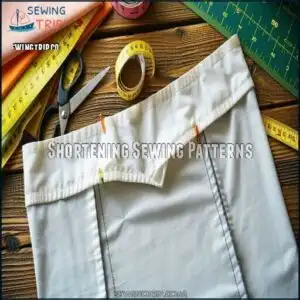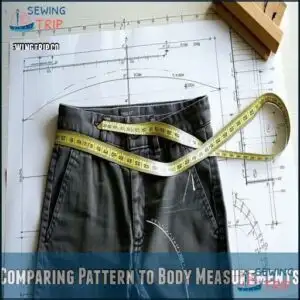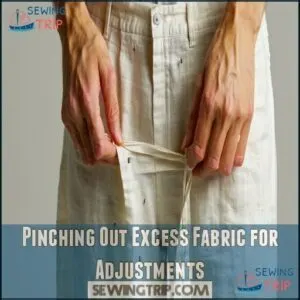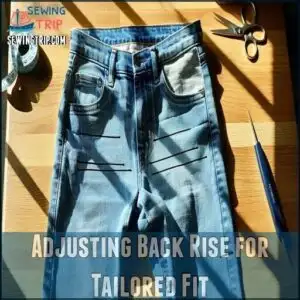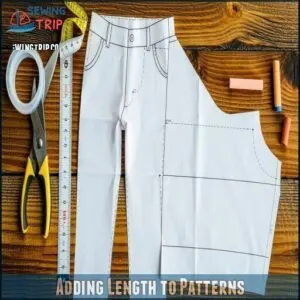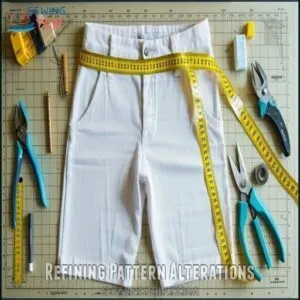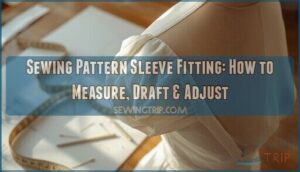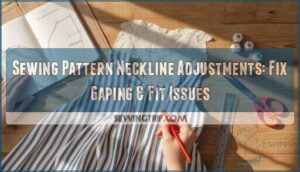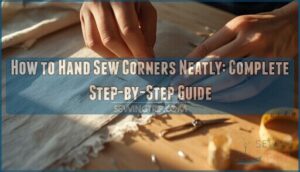This site is supported by our readers. We may earn a commission, at no cost to you, if you purchase through links.

First, measure your rise using a flexible tape, starting at your waistband and stopping at the seat of a chair while sitting. Compare this to the pattern’s measurement.
Fold the pattern piece horizontally between the waist and hip, pinching out the extra length. Tape it in place, ensuring the side seams stay aligned.
Don’t forget to smooth out your alterations for clean lines! Getting the fit right feels like tailoring freedom—small changes can make pants fit like they’re made just for you, and this is a key part of achieving a perfect fit, which leads to a sense of freedom.
Table Of Contents
Key Takeaways
- Measure your rise accurately with a flexible tape to pinpoint where you need adjustments in your pattern.
- Fold the pattern horizontally between waist and hip to remove excess length, keeping side seams aligned for smooth adjustments.
- Test fit with a muslin and mark changes, focusing on crotch depth and waistline placement for precision.
- Blend seam lines carefully after adjustments to ensure fluid transitions and maintain the original pattern’s style.
Shortening Sewing Patterns
Shortening sewing patterns might seem a bit tricky at first, but it’s all about folding and adjusting in the right spots.
Folding and adjusting in key spots transforms tricky sewing patterns into a perfect, comfortable fit effortlessly.
By focusing on areas like the waistline and considering proportions, you’ll create a more accurate and comfortable fit.
Identifying Short Waist Issues
When tackling short rise pants fitting issues, pinpointing the problem is key. A short waist often distorts waistline placement or rise length, making pants sit oddly.
Here’s how to spot it:
- Check if waistlines hit above your natural waist.
- Test fit using muslins for torso length accuracy.
- Assess body proportions against pattern measurements.
- Note fitting challenges like droopy or tight areas.
Folding Pattern Paper for Alterations
When altering a sewing pattern for a short rise, focus on folding techniques. Fold the pattern at horizontal changes, such as length adjustment lines, to remove excess length.
Use multiple shortening points for smooth results. Always smooth seams afterward to avoid jagged lines.
For major adjustments, consider adding paper to edges for precision. This rise alteration guide simplifies sewing pattern modifications.
Many sewers find a useful pattern shortening resource to be helpful in the process.
Considering Armscye and Bust Point Positions
When shortening a sewing pattern, don’t underestimate the armscye and bust point positions.
Incorrect placement impacts shoulder slope, sleeve fit, and torso length.
Adjust your armscye carefully to maintain comfort and mobility.
Verify bust point alterations align naturally with torso proportions.
A well-tuned armscye adjustment works like a puzzle piece, tying all pattern modifications into a cohesive, comfortable fit, ensuring a perfect torso length.
Adjusting Pattern Rise
Adjusting the rise in a pattern guarantees your pants fit comfortably without extra fabric bunching or pulling.
Adjusting the rise ensures pants fit smoothly, eliminating fabric bunching and creating a polished, comfortable look.
By measuring your rise and comparing it to the pattern, you’ll pinpoint exactly where changes are needed for a customized and polished fit.
Measuring Rise With Flexible Tape
Start by grabbing a flexible tape to measure your rise accurately.
Sit upright and locate these body landmarks: waist, hips, and crotch.
Follow these steps:
- Place tape at your natural waistline.
- Run it through your crotch.
- Pull it to your back waist.
- Verify the tape isn’t twisted.
- Record for consistent measurement comparisons.
Accurate pattern alterations rely on using high quality measuring tapes for accurate and consistent measurements.
Comparing Pattern to Body Measurements
Once you’ve measured your rise, compare it to the pants pattern’s rise length using size charts.
Focus on crotch depth alteration and body landmarks like the natural waistline. If the pattern rise feels off, account for pattern ease and adjust accordingly.
Accurate body measurements are essential for pattern alterations. A muslin fitting guarantees an accurate match, helping you nail the fit for your short rise adjustment.
Pinching Out Excess Fabric for Adjustments
After comparing measurements, test a short rise adjustment by pinching excess fabric during muslin fitting.
Pinch at the crotch depth where wrinkles or pulling appear, focusing on body proportions. Secure with pins and assess movement.
This excess removal improves measurement accuracy and refinement. Mark changes on your muslin to guide rise length adjustment, ensuring pattern alterations fit perfectly.
Altering Pants Patterns
When altering pants patterns, you’ll focus on adjusting the rise to match your unique proportions.
Whether you’re shortening for a petite frame or lengthening for added comfort, these small tweaks can make a big difference in fit.
Shortening Crotch Depth for Petite Individuals
For petite proportions, start by addressing pants pattern fitting issues with a crotch depth alteration.
Use muslin fitting to pinch out excess fabric along the crotch curve—1/4” or so often works.
Horizontally slash the pattern, adjust the rise length, and redraw smooth seams.
For adjustments, it’s key to verify crotch length adjustments for both front and back pieces.
Test comfort adjustments with a flexible tape and make certain the rise measurement feels right, ensuring a proper fit.
Lengthening Crotch Depth for Tall Individuals
When altering pants patterns for tall rise fit, add length to the front and back crotch depth between crotch and waist.
Use muslin fitting tips to tweak the crotch curve grading and guarantee smooth, proportionate adjustments.
Remember, inseam length impacts the overall fit, so check it carefully.
This crotch depth alteration keeps your pants pattern fitting perfectly balanced.
Adjusting Back Rise for Tailored Fit
If your customized fit needs tweaking, back rise shaping is key.
Start by cutting perpendicular to the side seam to adjust crotch depth.
Pivot for extra room or overlap to reduce it.
A muslin fitting analysis helps refine crotch curve refinement.
These seat adjustment techniques guarantee smoother patterns, resolving customized fit issues with minimal fuss.
Shortening the crotch curve can also improve the fit.
Pattern adjustments save future headaches!
Adding Length to Patterns
Adding length to a pattern might seem tricky, but it’s all about careful adjustments and smoothing seams.
You’ll extend the rise by adding paper where needed, ensuring the fit matches your unique proportions.
Extending Pattern Pieces for Longer Rise
To extend pattern pieces for a longer rise, use these easy steps:
- Cut a horizontal line on the pattern at the crotch curve grading point.
- Spread the pieces apart evenly, ensuring accurate inseam length impact.
- Tape extra paper to fill gaps and maintain the rise style preference.
Check muslin fitting issues and fabric drape consideration during pattern adjustments for height.
Blending Seam Lines for Smooth Finish
Smoothing jagged lines after pattern adjustment is vital for a professional finish.
Use blending techniques to align curved seams, ensuring smooth transitions. A handy tip? Trace over seam lines with a ruler or French curve, keeping edges fluid.
Understanding ease allowance needs consideration for comfort and style.
Seam smoothing refines pattern modifications and also enhances fitting techniques, making your sewing pattern alteration feel like pattern making mastery.
Adding Paper to Pattern Edges for Adjustments
When adding paper to pattern edges, use lightweight paper for easier manipulation and precise edge alignment.
Check the grainline impact to keep your project on track.
Match curves carefully, blending seams smoothly for a professional finish.
For best results, consider using specialized pattern materials for alterations.
This pattern adjustment tutorial emphasizes small, thoughtful steps during pattern modifications—perfect for sewing pattern alteration newbies or those refining their pattern-making tips.
Refining Pattern Alterations
Getting patterns just right takes patience and precision. Refining alterations is all about dialing in proportion balance and making iterative adjustments until the fit feels perfect.
Start by testing changes with muslin fitting—it’s a lifesaver for catching errors early. Focus on areas like grainline adjustments to guarantee your pants hang properly and front rise adjustments for comfort.
When tweaking crotch length, smooth out jagged seams using seam blending techniques. Always true up altered lines, making sure both sides match harmoniously. Low rise adjustment? No problem—small, targeted fixes go a long way in fitting pants better.
A solid pattern adjustment tutorial can guide you, but ultimately, it’s trial and error. Each tweak brings you closer to custom-fit perfection. Accurate measurements require specialized measuring devices for precise results.
Frequently Asked Questions (FAQs)
How to maintain original pattern style details?
Think of your pattern’s style details as delicate brushstrokes.
To keep them intact, carefully trace seam lines, darts, and features, adjusting proportions evenly.
Balance changes to preserve the original design essence without distortion, and make sure to keep the proportions adjusted evenly to maintain the integrity of the design.
What tools simplify accurate pattern marking adjustments?
Use tools like fabric pencils, tailor’s chalk, or fine-point markers to mark patterns precisely.
Add a clear ruler, French curve, and pattern notcher to your arsenal for clean, accurate adjustments every time, utilizing fine-point markers for precise work.
Can fabric choice affect rise adjustments?
Surprisingly, fabric choice can make or break rise adjustments.
Stiff fabrics may exaggerate fit issues, while stretchy ones hide flaws but affect accuracy.
Always test on muslin first—you’ll save headaches before cutting your final fabric, and this step is crucial for achieving the right fit.
How to address tightness after rise alterations?
To fix tightness after rise alterations, let out side seams slightly or adjust the crotch curve for extra room.
Test with a muslin, tweak incrementally, and make certain a smooth blend to prevent new fit issues.
Are darts necessary when shortening rise?
Shortening the rise is like fine-tuning an instrument—darts aren’t always required.
However, if the fabric pools at the waist or distorts the fit, adding small darts helps shape and smooth the final appearance.
Conclusion
Did you know poorly fitting pants are one of the top reasons 60% of people abandon sewing projects mid-way?
With pattern alteration for short rise, you can break that cycle. Adjusting the crotch and waist measurements guarantees a customized fit that’s both comfortable and flattering.
Mastering these simple techniques transforms frustration into confidence, letting you tweak patterns with ease. Now, you’ve got the tools to make every pair feel made just for you—time to get sewing!
- https://www.youtube.com/watch?v=-jnVVhuoh7Y
- https://lladybird.com/2018/06/05/tutorial-adjusting-crotch-depth-oal2018/
- https://www.joe.co.uk/gaming/tetris-block-names-221127
- https://inthefolds.com/q-a-series/2022/how-to-alter-pants-crotch-length
- https://handmadephd.com/2022/01/28/balancing-front-and-back-crotch-hook-lengths/

